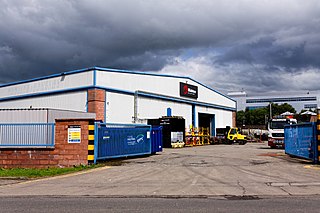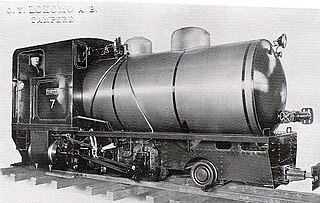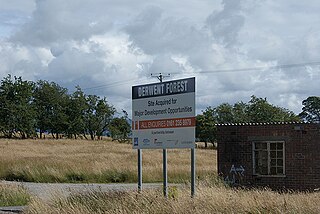
The Tanfield Railway is a 4 ft 8+1⁄2 instandard gauge heritage railway in Gateshead and County Durham, England. Running on part of a former horse-drawn colliery wooden waggonway, later rope & horse, lastly rope & loco railway. It operates preserved industrial steam locomotives. The railway operates a passenger service every Sunday, plus other days, as well as occasional demonstration coal, goods and mixed trains. The line runs 3 miles (4.8 km) between a southern terminus at East Tanfield, Durham, to a northern terminus at Sunniside, Gateshead. Another station, Andrews House, is situated near the Marley Hill engine shed. A halt also serves the historic site of the Causey Arch. The railway claims it is "the world's oldest railway" because it runs on a section dating from 1725, other parts being in use since 1621.

The Lincolnshire Wolds Railway (LWR) is a heritage railway based at Ludborough station, near Louth, Lincolnshire, England and the only standard gauge steam railway in Lincolnshire open to the public. The line is part of the original Great Northern Railway (GNR), a rail system that opened in 1848 and once linked Grimsby, Louth and East Lincolnshire with London. In early 2002, 2009 and 2013 the Lincolnshire Wolds Railway received a top national award from the Heritage Railway Association for its heritage railway efforts.

The Bowes Railway, built by George Stephenson in 1826, is the world's only operational preserved standard gauge cable railway system. It was built to transport coal from pits in Durham to boats on the River Tyne. The site is a scheduled monument. The railway is open every week on Thursday, Friday and Saturday as well as on a number of event days throughout the year.
Peak Rail is a preserved railway in Derbyshire, England, which operates a steam and heritage diesel service for tourists and visitors to both the Peak District and the Derbyshire Dales.

The Rushden, Higham and Wellingborough Railway is a heritage railway operated by the Rushden Historical Transport Society in the town of Rushden in the county of Northamptonshire, England.

Rutland Railway Museum, now trading as Rocks by Rail: The Living Ironstone Museum, is a heritage railway on part of a former Midland Railway mineral branch line. It is situated north east of Oakham, in Rutland, England.
The Strathspey Railway (SR) in Badenoch and Strathspey, Highland, Scotland, operates a ten-mile (16 km) heritage railway from Aviemore to Broomhill, Highland via Boat of Garten, part of the former Inverness and Perth Junction Railway which linked Aviemore with Forres. It is one of only a handful of former primary/secondary main lines to be preserved in Britain today.

The Alderney Railway on Alderney is the only railway in the Bailiwick of Guernsey, and the only working railway in the Channel Islands. The Alderney Railway opened in 1847 and runs for about 2 miles (3.2 km), mostly following a coastal route, from Braye Road to Mannez Quarry and Lighthouse.

The Northamptonshire Ironstone Railway Trust operates a 1+1⁄2-mile (2.4 km) long heritage railway line at Hunsbury Hill, south-west of Northampton. The line is mainly dedicated to freight working, featuring many sharp curves and steep gradients which were typical of the industrial railway, but rides are available in a variety of vehicles including a converted brake van.

The East Anglian Railway Museum is located at Chappel and Wakes Colne railway station in Essex, England, which is situated on the former Great Eastern Railway branch line from Marks Tey to Sudbury. Services on the Sudbury Branch Line are operated by Abellio Greater Anglia.

The Cambrian Heritage Railways is a heritage railway company, trust and society based at both Llynclys and Oswestry in its newly restored Oswestry railway station, Shropshire, England.

The Telford Steam Railway (TSR) is a heritage railway located at Horsehay, Telford in Shropshire, England, formed in 1976.

Andrew Barclay Sons & Co., currently operating as Brodie Engineering, is a railway engineering company, specializing in the heavy maintenance, refurbishment and overhauls for both passenger and freight rolling stock. Based around its works at Kilmarnock, it is the only active rail engineering business in Scotland.

The Northampton and Lamport Railway is a standard gauge heritage railway in Northamptonshire, England. It is based at Pitsford and Brampton station, near the villages of Pitsford and Chapel Brampton, roughly 5 miles (8.0 km) north of Northampton.

The Pontypool and Blaenavon Railway is a 3.5-mile (5.6 km) volunteer-run heritage railway in South Wales, running trains between a halt platform opposite the Whistle Inn public house southwards to the town of Blaenavon via a two-platform station at the site of former colliery furnace of the Big Pit National Coal Museum.

A fireless locomotive is a type of locomotive which uses reciprocating engines powered from a reservoir of compressed air or steam, which is filled at intervals from an external source. They offer advantages over conventional steam locomotives of lower cost per unit, cleanliness, and decreased risk from fire or boiler explosion; these are counterbalanced by the need for a source to refill the locomotive, and by the limited range afforded by the reservoir.

Southall Railway Centre is a non-publicised railway heritage centre at Southall in west London, near Southall railway station and the Grand Union Canal. Formerly of the Great Western Railway, the site is now run partly by Locomotive Services and West Coast Railways, both of whom lease the site from Network Rail. The location is not open to the public.

The Yeovil Railway Centre is a small railway museum at Yeovil Junction on the L&SWR West of England Main Line between Salisbury and Exeter in the U.K.

RNAD Broughton Moor is a decommissioned Royal Naval Armaments Depot located between Great Broughton and Broughton Moor in the County of Cumbria, England.


















